Historic Sites in San Luis Obispo County
There are 13 properties and districts listed as California Historical Landmarks in San Luis Obispo County, 37 sites listed on the National Register of Historic Places, three of which are also designated as National Historic Landmarks.
 Ah Louis Store 800 Palm Street, San Luis Obispo. Here in 1874 was established Ah Louis store. The first Chinese store in the county, it sold general merchandise and herbs and served as a bank, counting house, and post office for the numerous Chinese coolies who dug the eight tunnels through the mountains of Cuesta for the Southern Pacific Railroad, 1884 to 1894. California State Historic Landmark No. 802.
Ah Louis Store 800 Palm Street, San Luis Obispo. Here in 1874 was established Ah Louis store. The first Chinese store in the county, it sold general merchandise and herbs and served as a bank, counting house, and post office for the numerous Chinese coolies who dug the eight tunnels through the mountains of Cuesta for the Southern Pacific Railroad, 1884 to 1894. California State Historic Landmark No. 802.


Archeological Site 4 SLO 834 is a prehistoric archaeological site on the west bank of the Salinas River in Atascadero.



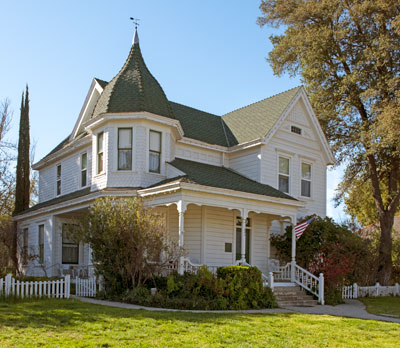 Brewster-Dutra House 1803 Vine Street, Paso Robles. The Brewster-Dutra House is one of the oldest and finest remaining houses in the city of Paso Robles. It is an outstanding local example of late 19th century Queen Anne architecture. Built in the early 1890s for G.W. and Mary Brewster, the house was lost in 1905 in a bank foreclosure but Mrs. Brewster redeemed it a year later and continued to live in it until her death in 1931. The house saw a succession of occupants until purchased by the present owners in 1975. Since purchase and extensive restoration of the house the owners often conduct tours by special appointment.
Brewster-Dutra House 1803 Vine Street, Paso Robles. The Brewster-Dutra House is one of the oldest and finest remaining houses in the city of Paso Robles. It is an outstanding local example of late 19th century Queen Anne architecture. Built in the early 1890s for G.W. and Mary Brewster, the house was lost in 1905 in a bank foreclosure but Mrs. Brewster redeemed it a year later and continued to live in it until her death in 1931. The house saw a succession of occupants until purchased by the present owners in 1975. Since purchase and extensive restoration of the house the owners often conduct tours by special appointment.

 Carrizo Plain Rock Art Discontiguous District in southeastern San Luis Obispo County, is part of the 246,812-acre Carrizo Plain National Monument, the largest single native grassland remaining in California, which includes Painted Rock, a smooth horseshoe-shaped marine sandstone rock formation with pictograph rock art created by the Chumash, Salinan and Yokuts peoples over many thousands of years.
Carrizo Plain Rock Art Discontiguous District in southeastern San Luis Obispo County, is part of the 246,812-acre Carrizo Plain National Monument, the largest single native grassland remaining in California, which includes Painted Rock, a smooth horseshoe-shaped marine sandstone rock formation with pictograph rock art created by the Chumash, Salinan and Yokuts peoples over many thousands of years.
Corral de Piedra South of San Luis Obispo on Price Canyon Road, San Luis Obispo.

 Dana Adobe 671 South Oakglen Avenue, Nipomo. Rancho Nipomo, almost 38,000 acres in size, was granted to Boston sea captain, William Goodwin Dana, in 1837. The Rancho for many years was the first stopping place on El Camino Real south of Mission San Luis Obispo. From 1839 until Dana’s death in 1858, the Rancho was known throughout the state as a hospitable stopping place for travellers, including Captain John C. Fremont, Edwin Bryant, and General Henry W. Halleck. In 1847 the “Dana Ranch” became one of four designated exchange points on California’s first U. S. Mail Route. California Registered Historical Landmark No. 1033. website
Dana Adobe 671 South Oakglen Avenue, Nipomo. Rancho Nipomo, almost 38,000 acres in size, was granted to Boston sea captain, William Goodwin Dana, in 1837. The Rancho for many years was the first stopping place on El Camino Real south of Mission San Luis Obispo. From 1839 until Dana’s death in 1858, the Rancho was known throughout the state as a hospitable stopping place for travellers, including Captain John C. Fremont, Edwin Bryant, and General Henry W. Halleck. In 1847 the “Dana Ranch” became one of four designated exchange points on California’s first U. S. Mail Route. California Registered Historical Landmark No. 1033. website
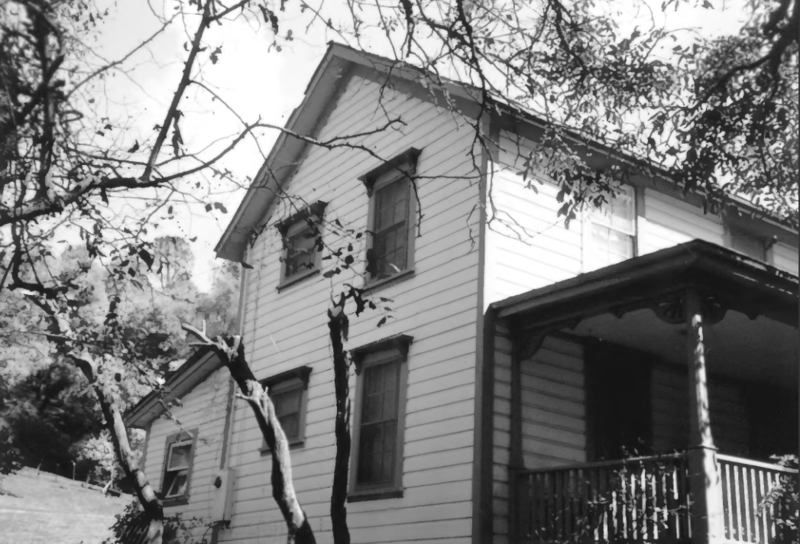 Eight Mile House off Highway 101 on Stagecoach Road, Santa Margarita. Built in 1877, the Eight Mile House remains one of the oldest 19th century hotel buildings standing in San Luis Obispo County. As an inn on a still existing portion of the 1870s Stagecoach Road, it is part of the county's transportation annals. It’s founders, Reuben M. and Edwin P. Bean, contributed to the county’s early horticulture, commerce, and political activity, and to its pioneer history.
Eight Mile House off Highway 101 on Stagecoach Road, Santa Margarita. Built in 1877, the Eight Mile House remains one of the oldest 19th century hotel buildings standing in San Luis Obispo County. As an inn on a still existing portion of the 1870s Stagecoach Road, it is part of the county's transportation annals. It’s founders, Reuben M. and Edwin P. Bean, contributed to the county’s early horticulture, commerce, and political activity, and to its pioneer history.
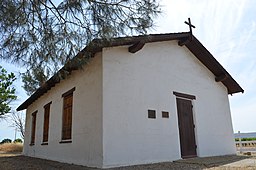
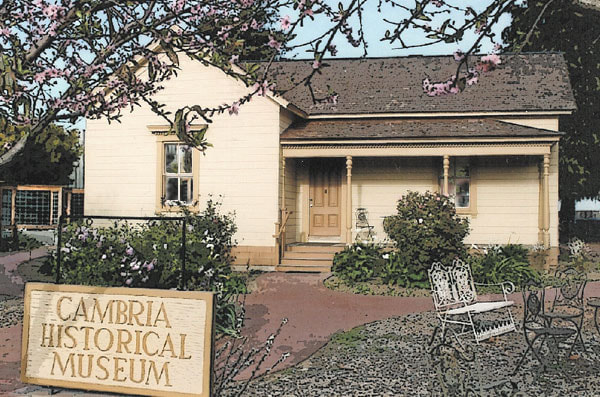 Guthrie-Bianchini House Burton and Center Streets, Cambria. One of Cambria’s oldest homes is the Guthrie-Bianchini House. Built in 1870 it is now the home of the Cambria Historical Museum. The Cambria Historical Society spent years restoring the home and then opened it as a museum in December 2008. website
Guthrie-Bianchini House Burton and Center Streets, Cambria. One of Cambria’s oldest homes is the Guthrie-Bianchini House. Built in 1870 it is now the home of the Cambria Historical Museum. The Cambria Historical Society spent years restoring the home and then opened it as a museum in December 2008. website
 Halcyon Historic District bounded by Halcyon Road, The Pike and Highway 1/Cienega Street, Halcyon. These 130 rural acres exemplify a settlement pattern and town planning unique to socialist reformers in the United States from the late nineteenth into the early twentieth century. Halcyon remains much the same physically and in spirit as when it was founded in 1903 by an offshoot of the Theosophical Society in America, who moved to California from Syracuse, New York. As a part of the large movement toward establishing utopian/intentional communities in the late nineteenth and early twentieth centuries, Halcyon is one of the few remaining such communities in California. The Temple of the People sanctuary, the Blue Star Memorial Temple, was designed by noted architect Theodore Eisen and constructed by Temple members in 1923 and 1924. more info
Halcyon Historic District bounded by Halcyon Road, The Pike and Highway 1/Cienega Street, Halcyon. These 130 rural acres exemplify a settlement pattern and town planning unique to socialist reformers in the United States from the late nineteenth into the early twentieth century. Halcyon remains much the same physically and in spirit as when it was founded in 1903 by an offshoot of the Theosophical Society in America, who moved to California from Syracuse, New York. As a part of the large movement toward establishing utopian/intentional communities in the late nineteenth and early twentieth centuries, Halcyon is one of the few remaining such communities in California. The Temple of the People sanctuary, the Blue Star Memorial Temple, was designed by noted architect Theodore Eisen and constructed by Temple members in 1923 and 1924. more info
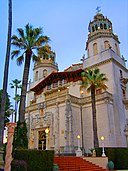 Hearst San Simeon Estate 3 miles Northeast of San Simeon. Here, on the historic Piedra Blanca Rancho, William Randolph Hearst created La Cuesta Encantada (The Enchanted Hill), including La Casa Grande and adjacent buildings, with their rare art treasures and beautiful gardens, 1919-1947. Presented to the State of California in 1958 by the Hearst Corporation as a memorial to William Randolph Hearst, and donated in the name of his mother, Phoebe Apperson Hearst. California State Historic Landmark No. 640. website
Hearst San Simeon Estate 3 miles Northeast of San Simeon. Here, on the historic Piedra Blanca Rancho, William Randolph Hearst created La Cuesta Encantada (The Enchanted Hill), including La Casa Grande and adjacent buildings, with their rare art treasures and beautiful gardens, 1919-1947. Presented to the State of California in 1958 by the Hearst Corporation as a memorial to William Randolph Hearst, and donated in the name of his mother, Phoebe Apperson Hearst. California State Historic Landmark No. 640. website

 Lincoln-Adelaida School 9000 Chimney Rock Road, Paso Robles. On April 18, 1917, Mr. and Mrs. Isaac Sims deeded this site of one and one half acres to and for the Lincoln School for the sum of $10.00 dollars. The school was built in 1917 and operated as a one room school house from 1917-1964. The school started serving the Adelaida elementary students in grades 1-8, in the fall of 1917. By 1925, the school buildings and grounds began to serve the Adelaida community as a meeting place. Major alterations came in 1948 when electricity arrived. The old gasoline lanterns were replaced with four new electric light fixtures. The school continues to be the community center for regular local club meetings, government workshops and social functions. more info
Lincoln-Adelaida School 9000 Chimney Rock Road, Paso Robles. On April 18, 1917, Mr. and Mrs. Isaac Sims deeded this site of one and one half acres to and for the Lincoln School for the sum of $10.00 dollars. The school was built in 1917 and operated as a one room school house from 1917-1964. The school started serving the Adelaida elementary students in grades 1-8, in the fall of 1917. By 1925, the school buildings and grounds began to serve the Adelaida community as a meeting place. Major alterations came in 1948 when electricity arrived. The old gasoline lanterns were replaced with four new electric light fixtures. The school continues to be the community center for regular local club meetings, government workshops and social functions. more info


 Monday Club of San Luis Obispo 1815 Monterey Street, San Luis Obispo. The Monday Club, dedicated on May 11, 1934, is an accomplished building in the Arts and Crafts style designed by the renowned Julia Morgan, the first woman licensed as an architect in the State of California. The nonprofit Monday Clubhouse Conservancy was established specifically to restore and preserve the historic clubhouse and continues to advance the goals of it’s founders to enhance the educational, civic, social and cultural quality of the community. website
Monday Club of San Luis Obispo 1815 Monterey Street, San Luis Obispo. The Monday Club, dedicated on May 11, 1934, is an accomplished building in the Arts and Crafts style designed by the renowned Julia Morgan, the first woman licensed as an architect in the State of California. The nonprofit Monday Clubhouse Conservancy was established specifically to restore and preserve the historic clubhouse and continues to advance the goals of it’s founders to enhance the educational, civic, social and cultural quality of the community. website
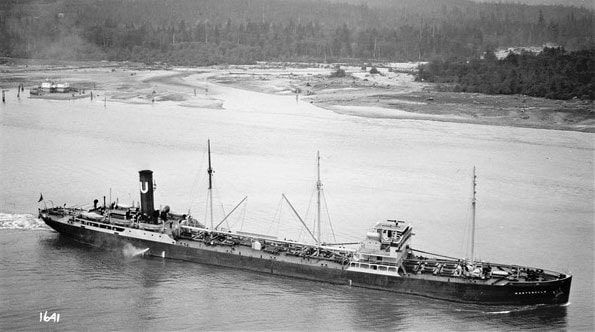 S.S. MONTEBELLO located off the coast of Cambria. Cambria Historical Society has two dramatic accounts of the sinking of the Montebello oil tanker ship by a Japanese submarine off the coast of Cambria on December 23, 1941. Read the accounts by Donald Young and eyewitness and Cambria resident Frank Gregg Goodall.
S.S. MONTEBELLO located off the coast of Cambria. Cambria Historical Society has two dramatic accounts of the sinking of the Montebello oil tanker ship by a Japanese submarine off the coast of Cambria on December 23, 1941. Read the accounts by Donald Young and eyewitness and Cambria resident Frank Gregg Goodall.
Morro Bay State Park Trailer and Tent Campground 20 State Park Road, Morro Bay.
 Morro Rock Southwest of Coleman Park, 101 Coleman Drive, Morro Bay. An important mariner’s navigational landfall for over 200 years. Chronicled in the diaries of Portola, Fr. Crespi, and Costanso in 1769 when they camped near this area on their trek to find Monterey. Sometimes called the “Gibraltar of the Pacific” it is the last in the famous chain of nine peaks which start in the city of San Luis Obispo. California State Historic Landmark No. 821.
Morro Rock Southwest of Coleman Park, 101 Coleman Drive, Morro Bay. An important mariner’s navigational landfall for over 200 years. Chronicled in the diaries of Portola, Fr. Crespi, and Costanso in 1769 when they camped near this area on their trek to find Monterey. Sometimes called the “Gibraltar of the Pacific” it is the last in the famous chain of nine peaks which start in the city of San Luis Obispo. California State Historic Landmark No. 821.
 Nitt Witt Ridge 881 Hillcrest Drive, Cambria. Nitt Witt Ridge, one of California’s remarkable twentieth century folk art environments, is the creation of Arthur Harold Beal (Der Tinkerpaw or Capt. Nitt Witt), a Cambria Pines pioneer, who sculpted the land using hand tools and indigenous materials, remarkable inventiveness, and self-taught skills. A blend of native materials and contemporary elements, impressive in its sheer mass and meticulous placement, it is a revealing memorial to Art’s unique cosmic humor and zest for life. California State Historic Landmark No. 939.
Nitt Witt Ridge 881 Hillcrest Drive, Cambria. Nitt Witt Ridge, one of California’s remarkable twentieth century folk art environments, is the creation of Arthur Harold Beal (Der Tinkerpaw or Capt. Nitt Witt), a Cambria Pines pioneer, who sculpted the land using hand tools and indigenous materials, remarkable inventiveness, and self-taught skills. A blend of native materials and contemporary elements, impressive in its sheer mass and meticulous placement, it is a revealing memorial to Art’s unique cosmic humor and zest for life. California State Historic Landmark No. 939.
 Old Santa Rosa Catholic Church and Cemetery Main Street, Cambria. The old Santa Rosa Catholic Church was the first church to be built in the village of Cambria, and remains as one of the oldest surviving structures in the town as well as in the county. It is an excellent example of the simple, Classically-inspired church architecture which was used in many rural California communities in the mid-19th century. more info
Old Santa Rosa Catholic Church and Cemetery Main Street, Cambria. The old Santa Rosa Catholic Church was the first church to be built in the village of Cambria, and remains as one of the oldest surviving structures in the town as well as in the county. It is an excellent example of the simple, Classically-inspired church architecture which was used in many rural California communities in the mid-19th century. more info
 Pacific Coast Railway Company Grain Warehouse 65 Higuera Street, San Luis Obispo. This structure is an excellent example of the once commonplace wood frame, corrugated iron industrial buildings that stretched out along local railroad tracks. It is the only remaining building from the Pacific Coast Railway Company San Luis Obispo headquarters complex and serves as a visual reminder of an era when the San Luis Obispo area was a major grain and bean-producing region.
Pacific Coast Railway Company Grain Warehouse 65 Higuera Street, San Luis Obispo. This structure is an excellent example of the once commonplace wood frame, corrugated iron industrial buildings that stretched out along local railroad tracks. It is the only remaining building from the Pacific Coast Railway Company San Luis Obispo headquarters complex and serves as a visual reminder of an era when the San Luis Obispo area was a major grain and bean-producing region.
Paso Robles Almond Growers Association Warehouse 525 Riverside Avenue, Paso Robles.
 Paso Robles Carnegie Library City Park, 800 12th Street, Paso Robles. The Paso Robles Carnegie Library, listed on the National Register of Historic Places. The grant for this library, $10,000, was awarded to the city by the Carnegie Foundation in 1906. No longer functioning as a library, the building now houses the Paso Robles area Historical Society Museum. This building was damaged in the 2003 San Simeon earthquake and has since been repaired.
Paso Robles Carnegie Library City Park, 800 12th Street, Paso Robles. The Paso Robles Carnegie Library, listed on the National Register of Historic Places. The grant for this library, $10,000, was awarded to the city by the Carnegie Foundation in 1906. No longer functioning as a library, the building now houses the Paso Robles area Historical Society Museum. This building was damaged in the 2003 San Simeon earthquake and has since been repaired.
 Pereira Octagon Barn 4400 Octagon Way, San Luis Obispo. The iconic local landmark on South Higuera is one of only two octagonal barns left in California and uniquely symbolizes the region’s agricultural roots. Built in 1906, it was used continuously for dairy operations into the 1950s. Since 1997 the Land Conservancy of San Luis Obispo County has led community efforts to restore the barn and revitalize the site for community benefit. website
Pereira Octagon Barn 4400 Octagon Way, San Luis Obispo. The iconic local landmark on South Higuera is one of only two octagonal barns left in California and uniquely symbolizes the region’s agricultural roots. Built in 1906, it was used continuously for dairy operations into the 1950s. Since 1997 the Land Conservancy of San Luis Obispo County has led community efforts to restore the barn and revitalize the site for community benefit. website
Piedras Blancas Light Station Highway 1 on Point Piedras Blancas, San Simeon. The lens at Piedras Blancas was first illuminated on February 15, 1875. In 1939, management was transferred to the United States Coast Guard. In 1975, the light was automated, the sound signal removed, and the light station was unmanned. The Bureau of Land Management (BLM) assumed management of the site in 2001 and was tasked to offer structured public access, allow site-specific research to continue, and restore the light station to its period of greatest historical significance (1875 to 1940). Today the lighthouse continues to serve as an aid to navigation and is managed as a historic park and wildlife sanctuary. website
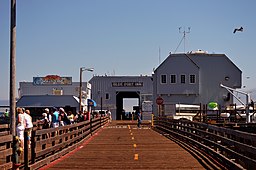
The Powerhouse South Perimeter Road and Cuesta Avenue, San Luis Obispo. The old powerhouse was built in 1908, and is the oldest building on the Cal Poly campus. It utilized student labor in its construction, thus embodying “learn by doing.” From 1910 to 1940 it supplied all of the electricity and steam heat for the campus. Most recently this building was occupied by the School of Architecture and Environmental Design.
 John Price House 100 Rancho Pismo Drive, Highland Drive off Price Canyon Road, Pismo Beach. The John Price House, also known as the Price Anniversary House, is a historic house built in 1894 by city founder John Michael Price for his wife Doña Andrea Colona Price to celebrate their 50th anniversary. It is the oldest building in Pismo Beach. website
John Price House 100 Rancho Pismo Drive, Highland Drive off Price Canyon Road, Pismo Beach. The John Price House, also known as the Price Anniversary House, is a historic house built in 1894 by city founder John Michael Price for his wife Doña Andrea Colona Price to celebrate their 50th anniversary. It is the oldest building in Pismo Beach. website
Rancho Cañada de los Osos y Pecho y Islay Los Osos Valley.
 Rios-Caledonia Adobe 700 South Mission Street, San Miguel. This imposing building is an excellent example of California’s Mexican era architecture. Using indian labor, Petronilo Rios built the two-story adobe about 1846 as his residence and headquarters for sheep and cattle operations. Named “Caledonia” in the 1860s, it served as a hotel and stagestop between Los Angeles and San Francisco until 1886. Restoration began in 1968 by the Friends of the Adobes. California State Historic Landmark No. 936. website
Rios-Caledonia Adobe 700 South Mission Street, San Miguel. This imposing building is an excellent example of California’s Mexican era architecture. Using indian labor, Petronilo Rios built the two-story adobe about 1846 as his residence and headquarters for sheep and cattle operations. Named “Caledonia” in the 1860s, it served as a hotel and stagestop between Los Angeles and San Francisco until 1886. Restoration began in 1968 by the Friends of the Adobes. California State Historic Landmark No. 936. website
 San Luis Obispo Carnegie Library 696 Monterey Street, San Luis Obispo. The San Luis Obispo Carnegie Library-County Museum building is an outstanding example of the Richardsonian Romanesque style, one of three buildings designed by master Architect William H. Weeks, of which two remain. The interior remains essentially intact as an excellent example of Mid-Victorian Parlor. Funded by the Carnegie foundation in 1903, the Library—built of local red bricks, Bishop’s Peak granite, and Los Berros sandstone—opened to the public and served the community until 1955. Since 1956 it has housed the San Luis Obispo County Historical Museum. website
San Luis Obispo Carnegie Library 696 Monterey Street, San Luis Obispo. The San Luis Obispo Carnegie Library-County Museum building is an outstanding example of the Richardsonian Romanesque style, one of three buildings designed by master Architect William H. Weeks, of which two remain. The interior remains essentially intact as an excellent example of Mid-Victorian Parlor. Funded by the Carnegie foundation in 1903, the Library—built of local red bricks, Bishop’s Peak granite, and Los Berros sandstone—opened to the public and served the community until 1955. Since 1956 it has housed the San Luis Obispo County Historical Museum. website
 San Luis Obispo Light Station Point San Luis, Avila Beach, is the only surviving Prairie Victorian model lighthouse that remains in existence on the West Coast. The lighthouse was completed and lit for the first time on June 30, 1890, with the steam powered fog whistle becoming operational in 1891. It has served as the beacon over San Luis Bay for 128 years. In 1992, the Port San Luis Harbor District received the site from the Federal Government, with the understanding that the light station be a historical, educational, and recreational site, for the use and enjoyment of the public. Today the non-profit Point San Luis Lighthouse Keepers runs weekly trolley tours, a docent led trail hike, hosts weddings, and has ongoing special events for the public. website
San Luis Obispo Light Station Point San Luis, Avila Beach, is the only surviving Prairie Victorian model lighthouse that remains in existence on the West Coast. The lighthouse was completed and lit for the first time on June 30, 1890, with the steam powered fog whistle becoming operational in 1891. It has served as the beacon over San Luis Bay for 128 years. In 1992, the Port San Luis Harbor District received the site from the Federal Government, with the understanding that the light station be a historical, educational, and recreational site, for the use and enjoyment of the public. Today the non-profit Point San Luis Lighthouse Keepers runs weekly trolley tours, a docent led trail hike, hosts weddings, and has ongoing special events for the public. website
 Santa Margarita de Cortona Asistencia at present-day Rancho Santa Margarita Hay Barn (private property, no trespassing), 1/4 mile north of intersection of Yerba Buena Ave and F Street, Santa Margarita. Established in 1787, this asistencia (“sub-mission”) served as an outpost, chapel and storehouse for Mission San Luis Obispo de Tolosa. website
Santa Margarita de Cortona Asistencia at present-day Rancho Santa Margarita Hay Barn (private property, no trespassing), 1/4 mile north of intersection of Yerba Buena Ave and F Street, Santa Margarita. Established in 1787, this asistencia (“sub-mission”) served as an outpost, chapel and storehouse for Mission San Luis Obispo de Tolosa. website
 The Sebastian Store This is the oldest store building along the north coast of San Luis Obispo County. Built in 1852 at Whaling Point, one half mile westward, it was moved in 1878 to its present location. Operated by the Sebastian family for half century, it is now owned and operated by J.C. and Louise Sebastian. California State Historic Landmark No. 726.
The Sebastian Store This is the oldest store building along the north coast of San Luis Obispo County. Built in 1852 at Whaling Point, one half mile westward, it was moved in 1878 to its present location. Operated by the Sebastian family for half century, it is now owned and operated by J.C. and Louise Sebastian. California State Historic Landmark No. 726.

 Tribune-Republic Building 1763 Santa Barbara Street, San Luis Obispo. Built in 1873 it was moved to its present location in 1905. It is significant as the only surviving newspaper printing office in San Luis Obispo from its era, during 1873 to 1890, when four newspapers competed there.
Tribune-Republic Building 1763 Santa Barbara Street, San Luis Obispo. Built in 1873 it was moved to its present location in 1905. It is significant as the only surviving newspaper printing office in San Luis Obispo from its era, during 1873 to 1890, when four newspapers competed there.
Sources: California Historical Landmarks in San Luis Obispo County, California, National Register of Historic Places listings in San Luis Obispo County, California, List of National Historic Landmarks in California all on Wikipedia

